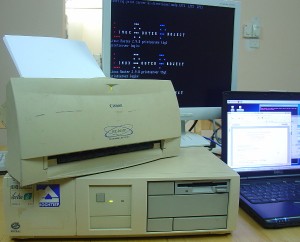December 13th, 2008
My brother-in-law had the worst Acer TravelMate laptop (a 528TE) in the world. It wasn’t a bad set of hardware, it was just that the plastic case had so completely degraded that he had to carry the laptop around in a cardboard box to keep all the pieces together. The Windows Me installation on it was so stuffed with malware it could barely run. I think I’d finally convinced him to buy a new laptop, when I decided to show him how well Xubuntu would run on his older laptop.

There seemed to be an issue with the BIOS, so I decided to flash it with a BIOS update long after I should have gone to bed. Confused by lack of sleep and a mysteriously long period of darkness on the monitor, I switched it off. That woke me up! I had of course completely ruined the BIOS. Since the case was in pieces, it was easy to see that the BIOS could only be replaced by soldering, so I apologised profusely and reminded him he’d decided to buy a new laptop anyway.
He opted for a Dell Vostro, their second-cheapest Core 2 Duo, with 2 GB of RAM and … nothing else matters really. I really liked the appearance of his Vostro, smaller and quite a bit lighter than my Inspiron 6400, it appears designed to my eye, as opposed to welded together from leftovers from the failed designs bin, like my Inspiron. But I would say I liked it, wouldn’t I, after destroying his old one?
His Vostro came with FreeDOS – I haven’t seen a desktop or laptop without Windows of some awful kind on the Singapore-based Dell site since he bought it. I installed Xubuntu 7.04 on it, and he was thrilled to bits. Until he’d spent a day at work and realised his old Canon Bubble Jet BJC-265SP had a parallel cable, and his new Vostro had no parallel port! I briefly considered getting in contact with a person I saw advertising a not-quite-so-broken TravelMate near KL, intending to do something Frankensteinian (a hot BIOS swap!) to the pair, but realised it would be easier to just keep apologising. Still, if you live near KL and you can’t get rid of that TravelMate any other way, I still have some funny projects I might be able to use them both for.
Then I remembered he had an old PC shoved under a desk – what a piece of treasure when we dusted it off! A Hewlett Packard Vectra VE Series 2 5/75 – a proper PC! That’s an original Pentium 75MHz, from about 1996. We thanked Hochtief for having cared enough to have employed his sister (my wife) a decent lifetime ago and having the foresight to spend the extra on buying indestructable PCs, and started it up. It tried to boot off a hard disk that sounded like an angle grinder, but the Windows for Workgroups on it had needed files missing. But it seemed to be a working piece of kit. It had a 10Mbit/s BNC/RJ45 ethernet adapter in it, and a parallel port, so it seemed like it could solve the new laptop / old printer issue.
You’re right, he could have bought a USB parallel adapter, but that would have been throwing good money after a printer that was probably near the end of its life anway, and when the printer dies, the USB parallel cable would be redundant. A quick search online turned up this fabulous page:
Network Print Server – by Nicholas Fong
The page is exactly what the Internet should be for. It claims to be a tutorial, and there is a lot of useful information on the page. But what it is is a join-the-dots DIY Network Print Server manual. There’s hardly any thinking required on the reader’s part, so clearly has Nicholas explained the steps. The Network Print Server is based on the long-ago defunct Linux Router Project.
The Vectra was creaking a bit, but with the case off served as a reminder why it’s a good idea not to shave the last few sen off the price of a new PC. The thought that had gone into the internal design of the Vectra would have put plenty of modern systems to shame (I admit, I do still buy the occasional mongrel of a system). With the power and data cables removed from the hard disk drive, the Vectra was much quieter. HP quotes the power consumption of that PC as about 20W with Windows 3.0 – I’ll try to remember to put it on the power meter sometime, and post the result. The Network Print Server boot disk is a single high density 3.5″ diskette, so it makes a bit of noise at startup and is dead quiet after that.
We set it up in my brother in law’s office with no monitor and no keyboard, and I forgot about it. It Just Worked(TM) – I tried turning it off and on a few times and different combinations of print jobs, and it worked flawlessly. I forgot about it after that. If it crossed my mind, I assumed it had burst into flames, or the last 3.5″ high density diskette in Malaysia had finally worn out. I asked my brother in law about it from time to time, and he was adamant that it was working. I thought he might be just saying that to make me feel better, and had quietly gone out to buy a USB / parallel adapter at the first opportunity.
About 18 months after we’d set up the Vectra as a Network Print Server, he came to visit us and brought his laptop with him. He’d obviously forgotten what I’d done to the previous one and said he wanted it upgraded. It wasn’t that anything wasn’t working, he’d met a girl he liked, and they’d spent a miserable afternoon IMing each other over lattes in Starbucks. She had a new laptop with Vista on it, and she’d said something sniffy about his XFCE desktop with the default window manager settings. I’m a GUI luddite myself, so I said I’d upgrade his laptop to Intrepid Ibex and he could try out some of the new GUI tweaks to see if it improved his love life. He’s very keen on the LED-style min/max/restore controls and transparent windows. He didn’t like the ‘floppy’ window effect, perhaps he thought it would send the wrong message while he’s still single.
My home network has a squid proxy cache on it, and me and my wife use Xubuntu on our desktops, so it only took a few minutes to update his. He was back the next day with the Vectra and the Canon printer, complaining that his laptop could no longer print. I’d broken his network config when I ‘upgraded’ his laptop, such that the ethernet port on his laptop wasn’t being assigned an Internet Address, so couldn’t communicate with the Network Printer Server. I didn’t know that at first, so added a monitor and keyboard to the Vectra – see the photo above. I’ve got to confess to being surprised to see it still working, solid as a rock.
My brother-in-law has an eye for a bargain, and won’t let anybody say a bad thing about the Vectra. It’s quite simply everything a computer should be: silently working without a fault, and hasn’t asked for a single ringgit in upkeep. OK, so it probably wouldn’t win him many admiring glances if he brought it into Starbucks with him, but there is always the chance a pretty girl will run up and say “I know this – this is a UNIX system!”, isn’t there?
If you’ve got some old kit lying about that you haven’t got round to throwing away because you think it has some utility left, but there doesn’t seem to be any way of extracting it, I heartily recommend comparing it to the requirements on Nichols Fong’s page. You might just find you had a perfect computer network propping up your desk all this time.
Posted in Breaktime, Broken, Fixed, Google, hardware | 4 Comments »


